
Grevillea levis is a species of flowering plant in the family Proteaceae and is endemic to the west of Western Australia. It is a dense shrub with divided leaves, the end lobes linear and sharply pointed, and clusters of white to cream-coloured flowers, sometimes flushed with pink.

Grevillea obtecta, commonly known as Fryerstown grevillea, Elphinstone grevillea or Taradale grevillea, is a species of flowering plant in the family Proteaceae and is endemic to Victoria in Australia. It is a prostrate, clumping or straggling shrub with pinnatifid, pinnatipartite or toothed leaves, and toothbrush-like clusters of light green to yellowish and purplish to black flowers with a dull yellow to pink style.
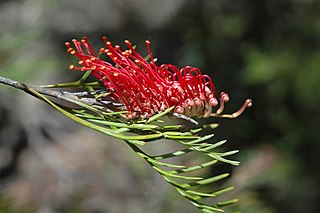
Grevillea hookeriana, commonly known as red toothbrushes or Hooker's grevillea, is a species of flowering plant in the family Proteaceae and is endemic to the south-west of Western Australia. It is a spreading to erect shrub, usually with linear leaves or deeply divided leaves with linear lobes, and toothbrush-shaped groups of red, black or yellowish green flowers, the style maroon to black.

Grevillea georgeana is a species of flowering plant in the family Proteaceae and is endemic to inland areas of south-western Western Australia. It is an erect to widely spreading shrub with deeply divided leaves, the end lobes linear and sharply pointed, and scarlet to bright reddish-pink and cream-coloured flowers.
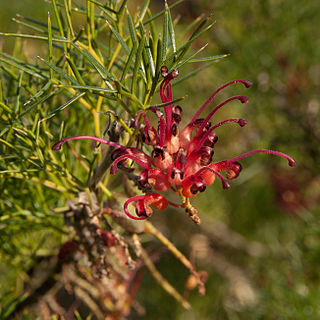
Grevillea maxwellii is a species of flowering plant in the family Proteaceae and is endemic to the south west region of Western Australia. It is low-lying to spreading shrub divided leaves with linear, sharply-pointed lobes, and clusters of pinkish-orange to pinkish-red flowers with a deep pinkish red style.

Grevillea ilicifolia, commonly known as holly grevillea or holly bush, is a species of flowering plant in the family Proteaceae and is endemic to southern continental Australia. It is a spreading to prostrate shrub with holly-like leaves with sharply-pointed triangular to egg-shaped teeth or lobes, and clusters of green to cream-coloured and mauve flowers with a pink to red style.

Grevillea huegelii, commonly known as comb spider-flower or comb grevillea, is a species of flowering plant in the family Proteaceae and is endemic to southern continental Australia. It is an erect to low-lying shrub with divided leaves with mostly three to eleven sharply-pointed linear lobes, and clusters of red to pink flowers that are silky-hairy on the outside.
Grevillea kirkalocka is a species of flowering plant in the family Proteaceae and is endemic to inland Western Australia. It is a low, spreading shrub with divided leaves with sharply-pointed linear lobes and clusters of red flowers.

Grevillea nana, commonly known as dwarf grevillea, is a species of flowering plant in the family Proteaceae and is endemic to the south-west of Western Australia. It is a prostrate to low, mounded, dense shrub with divided leaves with sharply-pointed, linear lobes, and clusters of pink, ornage, yellow or red flowers.

Grevillea benthamiana is a species of flowering plant in the family Proteaceae and is endemic to the Northern Territory. It is a shrub with bipinnate leaves that have linear lobes, and reddish flowers that turn black.
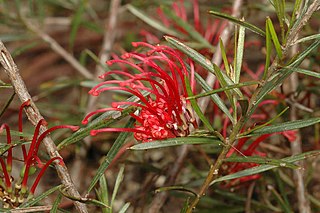
Grevillea molyneuxii, commonly known as Wingello grevillea, is a species of flowering plant in the family Proteaceae and is endemic to a restricted area of south-eastern New South Wales. It is a spreading shrub with narrowly oblong or narrowly elliptic to linear leaves and cylindrical clusters of reddish flowers.

Grevillea formosa, also known as the Mount Brockman grevillea, is a species of flowering plant in the family Proteaceae and is endemic to Arnhem Land in the Northern Territory. It is a prostrate to sprawling shrub with deeply divided leaves, the lobes sometimes further divided, the end leaflets linear, and green flowers that turn bright golden-yellow.
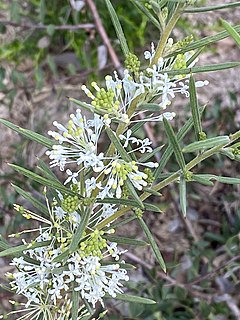
Grevillea biternata is a species of flowering plant in the family Proteaceae and is endemic to the south-west of Western Australia. It is a shrub with divided leaves with linear lobes and clusters of white flowers.

Grevillea fastigiata is a species of flowering plant in the family Proteaceae and is endemic to the south-west of Western Australia. It is an erect shrub with clustered branches, linear leaves sometimes with rigid lobes near the tip, and clusters of brownish or scarlet flowers.
Grevillea longicuspis is a species of flowering plant in the family Proteaceae and is endemic to a small area of the Northern Territory in Australia. It is a shrub with divided leaves that are egg-shaped in outline with sharply-pointed teeth or lobes, and clusters of red flowers with a red or creamy pink style.

Grevillea newbeyi is a species of flowering plant in the family Proteaceae and is endemic to the south west region of Western Australia. It is a dome-shaped, prickly shrub with divided leaves, the end lobes linear, rigid and sharply-pointed, and clusters of smoky pink and creamy-white flowers with a pink style.

Grevillea hirtella is a species of flowering plant in the family Proteaceae and is endemic to the west of Western Australia. It is a spreading shrub with crowded linear and divided leaves and clusters of pale pink to deep red flowers.
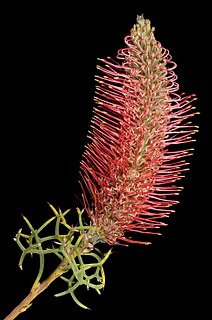
Grevillea paradoxa, commonly known as the bottlebrush grevillea, is a species of flowering plant in the family Proteaceae and is endemic to the south-west of Western Australia. It is an erect to spreading, prickly shrub with pinnatipartite leaves, the lobes linear, widely spreading and sharply pointed, and with cylindrical clusters of pale to dark pink or cream-coloured flowers with a pinkish-red style.

Grevillea muricata is a species of flowering plant in the family Proteaceae and is endemic to Kangaroo Island in South Australia. It is a low, spreading shrub with narrowly oblong to more or less linear to cylindrical leaves and small groups of bright orange-red flowers.

Grevillea neorigida is a species of flowering plant in the family Proteaceae and is endemic to Western Australia. It is compact, spreading shrub with deeply-divided leaves, the end lobes linear and somewhat sharply-pointed, and clusters of creamy-brown to off-white flowers with a scarlet or orange-red style.


















